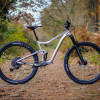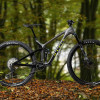Nukeproof reinvents the Reactor as a modern trail bike

Nukeproof has just launched a new trail bike bearing the namesake of an old school hardtail from 20 years ago. This new bike looks well sorted with modern geometry, a flip-chip for angle adjustment and carbon seat stays on alloy bikes to reduce unsprung weight.
- First Look: 2019 Nukeproof Digger Pro - the gravel bike for mountain bikers
- First Look: Nukeproof Scout 275 Sport aluminium hardtail
- Best mountain bikes for under £3,000 - capable trail bikes that won't break the bank
Taking its name from the original 1996 Nukeproof Reactor trail frame, it's clear to see a lot has changed in the last 23 years. The new bike has rear suspension, 140mm on 27.5" bikes and 130mm on the 29er version (RS version gets +10mm front/rear), there are carbon and alloy frames and not to mention geometry that will suit most of the UK riding pretty well indeed.
Nukeproof says that from concept through to design, the Reactor is designed from the ground up to be the ultimate aggressive trail bike. At home on technical climbs, but happiest when thrashing the most technical trails you can point it at.
They say they have ensured the bike could climb as well as it descends, with a four bar horst linkage designed to have higher levels of anti-squat for climbing gears, but lower levels when you drop down the cassette. Nukeproof says that on the trail this means that the bike can behave itself on the climbs but when you get it up to speed, it turns into a trail hooligan.
Nukeproof are offering riders a full carbon frame in 27.5” & 29” wheel size options, previously the brands' carbon bikes (the Mega C) have had alloy rear ends. In addition to this, there are 27.5” & 29” aluminium frame options which feature carbon seat stays to help reduce the unsprung weight, something we find very curious about given the heavy SRAM SX cassettes specced in these lower priced models.
There is also a flip chip to adjust the geometry from what Nukeproof are calling “Trail” or “Rail mode”. Trail, they say is best suited to trail riding, for those riding both uphill and downhill. This mode (example for 290 bike) gives a 66 degree head angle and a 75.5 degree effective seat tube angle. The Rail mode slackens the head angle and the effective seat tube angles by half a degree to 65.5 and 75 degrees, it also lowers the bottom bracket by 6mm to 330mm to maximise the descending capability of the bike. The 275 bike is slightly slacker at both of these angles 65/65.5 and 75/74.5 respectively.
Elsewhere on the geometry chart, the bike in a size large with 29er wheels gets a 480mm reach, 440mm chainstays and a 1235mm wheelbase. The smaller wheeled 275 bike gets a 475mm reach, 440mm chainstays and a 1239mm wheelbase.
The bike also features a down tube protector, internal cable routing and what looks like a chain slap silencing rubber covering on the drive side chainstay akin to the likes of that seen on Specialized Stumpjumpers.
There are 6 specification levels and all are available in both 27.5” or 29” frames (275: S, M, L, X / 290: M, L, XL). Alloy options include the Comp and the Expert with prices starting at £2745.00. Carbon bikes are the Elite, Pro, Factory and RS starting at £3,799.99. You can also get a carbon frame only for £2,499.99 and an alloy frame only for £1,899.99.
You might also like:
- Your complete guide to SRAM MTB drivetrains, from AXS and XX1 Eagle to NX
- Your complete guide to the RockShox fork range
- The best trail and enduro mountain bike wheelsets, tried and tested























